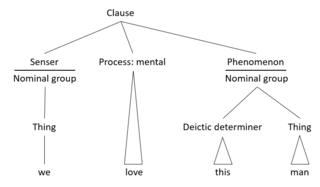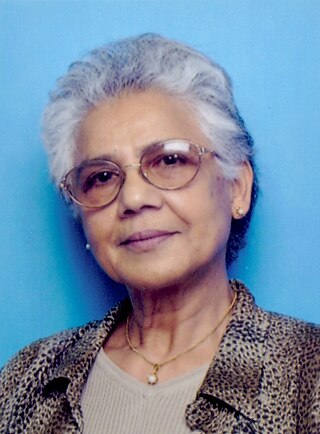
Functional linguistics is an approach to the study of language characterized by taking systematically into account the speaker's and the hearer's side, and the communicative needs of the speaker and of the given language community. Linguistic functionalism spawned in the 1920s to 1930s from Ferdinand de Saussure's systematic structuralist approach to language (1916).
The following outline is provided as an overview and topical guide to linguistics:

Michael Alexander Kirkwood Halliday was a British linguist who developed the internationally influential systemic functional linguistics (SFL) model of language. His grammatical descriptions go by the name of systemic functional grammar. Halliday described language as a semiotic system, "not in the sense of a system of signs, but a systemic resource for meaning". For Halliday, language was a "meaning potential"; by extension, he defined linguistics as the study of "how people exchange meanings by 'languaging'". Halliday described himself as a generalist, meaning that he tried "to look at language from every possible vantage point", and has described his work as "wander[ing] the highways and byways of language". But he said that "to the extent that I favoured any one angle, it was the social: language as the creature and creator of human society".
In linguistics, the topic, or theme, of a sentence is what is being talked about, and the comment is what is being said about the topic. This division into old vs. new content is called information structure. It is generally agreed that clauses are divided into topic vs. comment, but in certain cases the boundary between them depends on which specific grammatical theory is being used to analyze the sentence.
Text linguistics is a branch of linguistics that deals with texts as communication systems. Its original aims lay in uncovering and describing text grammars. The application of text linguistics has, however, evolved from this approach to a point in which text is viewed in much broader terms that go beyond a mere extension of traditional grammar towards an entire text. Text linguistics takes into account the form of a text, but also its setting, i. e. the way in which it is situated in an interactional, communicative context. Both the author of a text as well as its addressee are taken into consideration in their respective roles in the specific communicative context. In general it is an application of discourse analysis at the much broader level of text, rather than just a sentence or word.

Systemic functional linguistics (SFL) is an approach to linguistics, among functional linguistics, that considers language as a social semiotic system.
In linguistics, a non-finite clause is a dependent or embedded clause that represents a state or event in the same way no matter whether it takes place before, during, or after text production. In this sense, a non-finite dependent clause represents one process as a circumstance for another without specifying the time when it takes place as in the following examples:
Cohesion is the grammatical and lexical linking within a text or sentence that holds a text together and gives it meaning. It is related to the broader concept of coherence.
Social semiotics is a branch of the field of semiotics which investigates human signifying practices in specific social and cultural circumstances, and which tries to explain meaning-making as a social practice. Semiotics, as originally defined by Ferdinand de Saussure, is "the science of the life of signs in society". Social semiotics expands on Saussure's founding insights by exploring the implications of the fact that the "codes" of language and communication are formed by social processes. The crucial implication here is that meanings and semiotic systems are shaped by relations of power, and that as power shifts in society, our languages and other systems of socially accepted meanings can and do change.

In systemic functional grammar (SFG), a nominal group is a group of words that represents or describes an entity, for example The nice old English police inspector who was sitting at the table with Mr Morse. Grammatically, the wording "The nice old English police inspector who was sitting at the table with Mr Morse" can be understood as a nominal group, which functions as the subject of the information exchange and as the person being identified as "Mr Morse".

Ruqaiya Hasan was a professor of linguistics who held visiting positions and taught at various universities in England. Her last appointment was at Macquarie University in Sydney, from which she retired as emeritus professor in 1994. Throughout her career she researched and published widely in the areas of verbal art, culture, context and text, text and texture, lexicogrammar and semantic variation. The latter involved the devising of extensive semantic system networks for the analysis of meaning in naturally occurring dialogues.
Lexicogrammar is a term directly related to systemic functional linguistics. Systemic functional linguistics is a specific approach to adding as much detail as possible when describing lexicogrammar. It was coined by Michael Halliday, the father of systemic functional linguistics, to describe the continuity between grammar and lexis. For many linguists, these phenomena are discrete. But Halliday brings them together with this term. As with other dimensions of Halliday's theory, he describes the relation of grammar to lexis as one of a 'cline', and therefore, one of 'delicacy'. In 1961, he wrote 'The grammarian's dream is...to turn the whole of linguistic form into grammar, hoping to show that lexis can be defined as "most delicate grammar". In 1987, Ruqaiya Hasan wrote an article titled 'The grammarian's dream: lexis as delicate grammar', in which she laid out a methodology for mapping lexis in Halliday's terms.

James Robert Martin is a Canadian linguist. He is Professor of Linguistics at The University of Sydney. He is the leading figure in the 'Sydney School' of systemic functional linguistics. Martin is well known for his work on discourse analysis, genre, appraisal, multimodality and educational linguistics.

Christian Matthias Ingemar Martin Matthiessen is a Swedish-born linguist and a leading figure in the systemic functional linguistics (SFL) school, having authored or co-authored more than 100 books, refereed journal articles, and papers in refereed conference proceedings, with contributions to three television programs. One of his major works is Lexicogrammatical cartography (1995), a 700-page study of the grammatical systems of English from the perspective of SFL. He has co-authored a number of books with Michael Halliday. Since 2008 he has been a professor in the Department of English at the Hong Kong Polytechnic University. Before this, he was Chair of the Department of Linguistics at Macquarie University in Sydney.
The term metafunction originates in systemic functional linguistics and is considered to be a property of all languages. Systemic functional linguistics is functional and semantic rather than formal and syntactic in its orientation. As a functional linguistic theory, it claims that both the emergence of grammar and the particular forms that grammars take should be explained "in terms of the functions that language evolved to serve". While languages vary in how and what they do, and what humans do with them in the contexts of human cultural practice, all languages are considered to be shaped and organised in relation to three functions, or metafunctions. Michael Halliday, the founder of systemic functional linguistics, calls these three functions the ideational, interpersonal, and textual. The ideational function is further divided into the experiential and logical.
Cryptotype or covert categories of a language is a concept coined by Benjamin Lee Whorf which describes semantic or syntactic features that do not have a morphological implementation, but which are crucial for the construction and understanding of a phrase. The cryptotype is understood in opposition to the phenotype or overt category, namely a category that is overtly marked as such. Covert categories affect words' combinative power.

The cline of instantiation is a concept in systemic functional linguistics theory. Alongside stratification and metafunction, it is one of the global semiotic dimensions that define the organization of language in context.
The idea of language as a linguistic system appears in the linguistic theory of Ferdinand de Saussure, J.R. Firth, Benjamin Lee Whorf, Louis Hjelmslev, and Michael Halliday.
Alice Marie-Claude Caffarel-Cayron is a French-Australian linguist. She is an Honorary Senior Lecturer in Linguistics at the University of Sydney. Caffarel is recognized for the development of a Systemic Functional Grammar of French which has been applied in the teaching of the French language, Discourse analysis and Stylistics at the University of Sydney. Caffarel is recognised as an expert in the field of French Systemic Functional Linguistics (SFL).
In linguistics, stratification is the idea that language is organized in terms of hierarchically ordered strata. This notion can be traced back to Saussure's dichotomy between signified and signifier and Hjelmslev's expression plane and content plane, but has been explicictly explored as a theoretical concept in stratificational linguistics and systemic functional linguistics.







